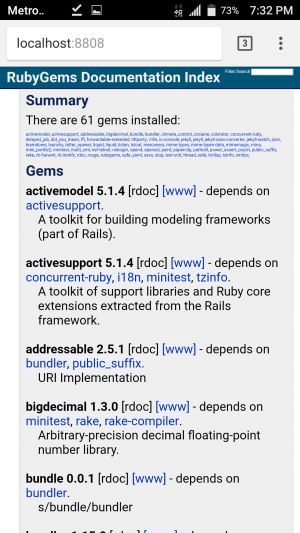Ruby: Difference between revisions
No edit summary |
|||
| (10 intermediate revisions by 6 users not shown) | |||
| Line 1: | Line 1: | ||
[[File:GemServer.png|thumb|Run <code>gem server</code> to see the this on your device.]] | |||
Ruby is a dynamic, open source programming language with a focus on simplicity and | |||
productivity. It has an elegant syntax that is natural to read and easy to write. | |||
In Termux Ruby can be installed by executing | |||
pkg install ruby | |||
'''Due to our infrastructure limits, we do not provide older versions of packages. If you accidentally upgraded to unsuitable Ruby version and do not have backups to rollback, do not complain! We recommend doing backups of $PREFIX for developers and other people who rely on specific software versions.''' | |||
== Package management == | |||
After installing ruby, <code>gem</code> package manager will be available. Here is a quick | |||
tutorial about its usage. | |||
Installing a new gem: | |||
= | gem install {package_name}</code> | ||
Uninstalling gem: | |||
gem uninstall {package name} | |||
Listing installed gems: | |||
gem list --local | |||
Launching a local documentation and gem repository server: | |||
gem server | |||
When installing Ruby gems, it is highly recommended to have a package <code>build-essential</code> | |||
to be installed - some gems compile native extensions during their installation. | |||
== Gem installation tips and tricks == | |||
''Tip: help us to collect more information about installing Ruby gems in Termux. You can also help to keep this information up-to-date, because current instructions may eventually become obsolete.'' | |||
{| class="wikitable" | |||
! style="text-align:left;"| Package | |||
! Description | |||
! Dependencies | |||
! Special Instructions | |||
|- | |||
|delayed_job | |||
|Database based asynchronous priority https://github.com/collectiveidea/delayed_job | |||
| | |||
| | |||
|- | |||
|ffi | |||
|A gem for loading dynamically-linked native libraries, binding functions within them https://github.com/ffi/ffi | |||
| | |||
| | |||
|- | |||
|jekyll | |||
|Tool for creating static websites https://github.com/jekyll/jekyll | |||
|ruby clang make libffi | |||
| | |||
|- | |||
|letter_opener | |||
|Preview mail in the browser instead of sending https://github.com/ryanb/letter_opener | |||
| | |||
| | |||
|- | |||
|lolcat | |||
|Prints rainbow colored text https://github.com/busyloop/lolcat | |||
| | |||
| | |||
|- | |||
|mina | |||
|Blazing fast application deployment tool https://github.com/mina-deploy/mina | |||
| | |||
| | |||
|- | |||
|nokogiri | |||
|XML and HTML library https://github.com/sparklemotion/nokogiri | |||
|libxslt libiconv pkg-config | |||
|gem install nokogiri -- --use-system-libraries | |||
|- | |||
|paperclip | |||
|Easy file attachment management for ActiveRecord https://github.com/thoughtbot/paperclip | |||
| | |||
| | |||
|- | |||
|thin | |||
|A very fast & simple Ruby web server https://github.com/macournoyer/thin | |||
|ruby make | |||
|gem install thin -- --use-system-libraries | |||
|} | |||
Latest revision as of 07:31, 17 October 2021

gem server to see the this on your device.Ruby is a dynamic, open source programming language with a focus on simplicity and productivity. It has an elegant syntax that is natural to read and easy to write.
In Termux Ruby can be installed by executing
pkg install ruby
Due to our infrastructure limits, we do not provide older versions of packages. If you accidentally upgraded to unsuitable Ruby version and do not have backups to rollback, do not complain! We recommend doing backups of $PREFIX for developers and other people who rely on specific software versions.
Package management
After installing ruby, gem package manager will be available. Here is a quick
tutorial about its usage.
Installing a new gem:
gem install {package_name}
Uninstalling gem:
gem uninstall {package name}
Listing installed gems:
gem list --local
Launching a local documentation and gem repository server:
gem server
When installing Ruby gems, it is highly recommended to have a package build-essential
to be installed - some gems compile native extensions during their installation.
Gem installation tips and tricks
Tip: help us to collect more information about installing Ruby gems in Termux. You can also help to keep this information up-to-date, because current instructions may eventually become obsolete.
| Package | Description | Dependencies | Special Instructions |
|---|---|---|---|
| delayed_job | Database based asynchronous priority https://github.com/collectiveidea/delayed_job | ||
| ffi | A gem for loading dynamically-linked native libraries, binding functions within them https://github.com/ffi/ffi | ||
| jekyll | Tool for creating static websites https://github.com/jekyll/jekyll | ruby clang make libffi | |
| letter_opener | Preview mail in the browser instead of sending https://github.com/ryanb/letter_opener | ||
| lolcat | Prints rainbow colored text https://github.com/busyloop/lolcat | ||
| mina | Blazing fast application deployment tool https://github.com/mina-deploy/mina | ||
| nokogiri | XML and HTML library https://github.com/sparklemotion/nokogiri | libxslt libiconv pkg-config | gem install nokogiri -- --use-system-libraries |
| paperclip | Easy file attachment management for ActiveRecord https://github.com/thoughtbot/paperclip | ||
| thin | A very fast & simple Ruby web server https://github.com/macournoyer/thin | ruby make | gem install thin -- --use-system-libraries |